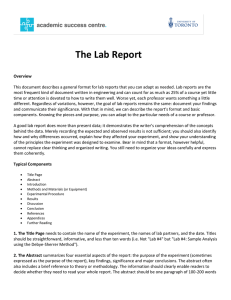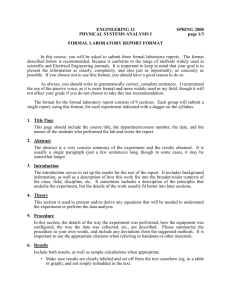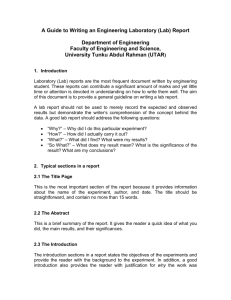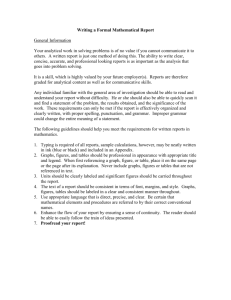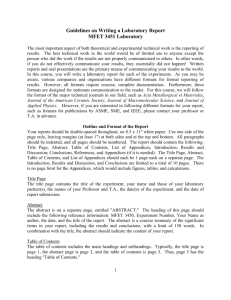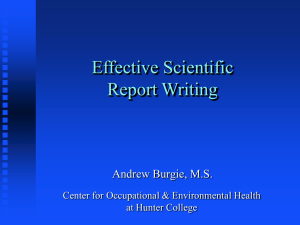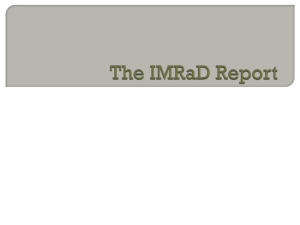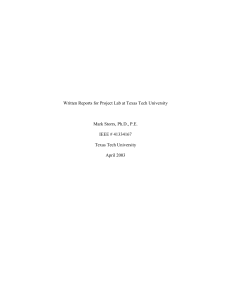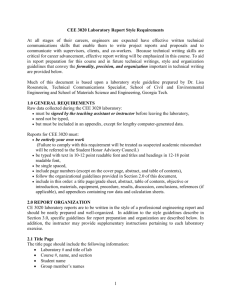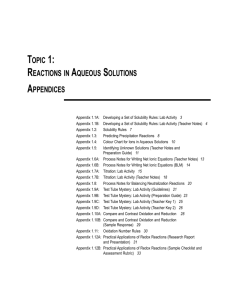A Quick Reference for Laboratory Report Writing
advertisement
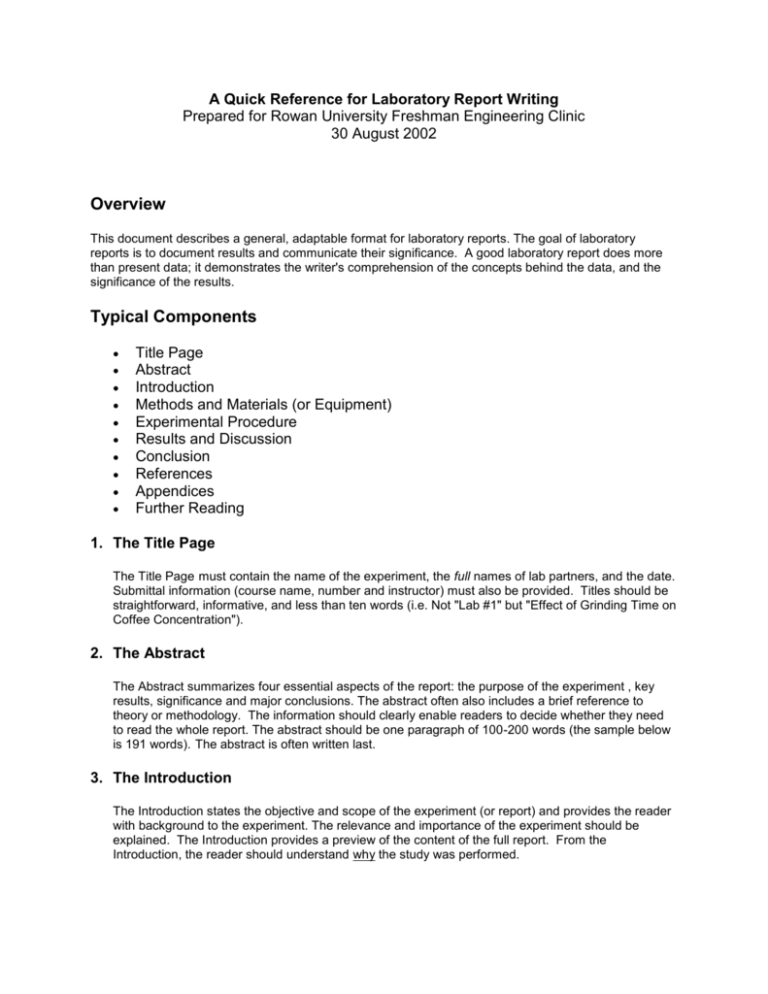
A Quick Reference for Laboratory Report Writing Prepared for Rowan University Freshman Engineering Clinic 30 August 2002 Overview This document describes a general, adaptable format for laboratory reports. The goal of laboratory reports is to document results and communicate their significance. A good laboratory report does more than present data; it demonstrates the writer's comprehension of the concepts behind the data, and the significance of the results. Typical Components Title Page Abstract Introduction Methods and Materials (or Equipment) Experimental Procedure Results and Discussion Conclusion References Appendices Further Reading 1. The Title Page The Title Page must contain the name of the experiment, the full names of lab partners, and the date. Submittal information (course name, number and instructor) must also be provided. Titles should be straightforward, informative, and less than ten words (i.e. Not "Lab #1" but "Effect of Grinding Time on Coffee Concentration"). 2. The Abstract The Abstract summarizes four essential aspects of the report: the purpose of the experiment , key results, significance and major conclusions. The abstract often also includes a brief reference to theory or methodology. The information should clearly enable readers to decide whether they need to read the whole report. The abstract should be one paragraph of 100-200 words (the sample below is 191 words). The abstract is often written last. 3. The Introduction The Introduction states the objective and scope of the experiment (or report) and provides the reader with background to the experiment. The relevance and importance of the experiment should be explained. The Introduction provides a preview of the content of the full report. From the Introduction, the reader should understand why the study was performed. Note on Verb Tense The experiment is already finished. Use the past tense when talking about the experiment. "The objective of the experiment was..." The report, the theory and permanent equipment still exist; therefore, these get the present tense when referring to these: "The purpose of this report is..." "The Ideal Gas Law is ..." "The Spectrophotometer measures ... 4. Background (or Theory) This section explains the scientific principles that apply to the experiment and are relevant to the analysis and interpretation of results. The background or theory section should explain relevant equations as well. 5. Methods and Materials (or Equipment) This section provides the source (company name and location) of all materials used, and the model and manufacturer for all specialized laboratory equipment, and a description of all methods of measurement. If a standard published method is used, it must be referenced appropriately. 6. Experimental Procedure This section describes the process in chronological order. Using clear paragraph structure, explain all steps in the order they were performed. If the procedure is properly described, another researcher should be able to duplicate the experiment. The procedure is always written in past tense and passive voice. Correct: Ground coffee was weighed on an analytical balance. Incorrect: We weighed ground coffee on an analytical balance You weigh coffee on an analytical balance Weigh the coffee on an analytical balance It should not be written in the same format as a laboratory handout, which instructs the experimenter to perform a series of steps. 7. Results and Discussion This section presents the findings and interprets their significance. All results should be explained, analyzed, and interpreted. Analysis and Interpretation What do the results indicate clearly? What is the significance of the results? Compare expected results with observed results. What ambiguities exist between the expected and observed results? Logical explanations should be provided. Analyze experimental error. Was it avoidable? Was it a result of equipment? If an experiment was within the tolerances, there can still be a deviation from the ideal. If the flaws result from the experimental design explain how the design might be improved. Explain results in terms of theoretical issues. When comparing observed results to expected results, the expected results should always be based on sound scientific principles. These principles, along with relevant equations, should be provided in the Theory (or Background) section of the report. Compare your results to similar investigations. It is desirable to compare your results to published results of related studies. If published information is unavailable, you may compare your results to those of other teams in the class. Analyze the strengths and limitations of your experimental design. This is particularly useful if a new or original design has been used. Use Graphs and Tables to provide a visual summary of results The results are often conveniently expressed using graphs, figures, and tables, but must always be explained in the text. It is never acceptable to present data in a graph or table without explaining them. Results must always be explained and analyzed in the text. It is never acceptable to simply present a table without specifically directing the reader to it in the text. Put Sample Calculations and Raw Data in Appendices. Sample calculations and raw data should be put in an Appendix. Refer to these Appendices in the report by directing the reader to them for the specific information provided (never just leave it up to the reader to discover the appendices). 8. Conclusions In this section the significance and implications of the findings are summarized. The conclusions must be consistent with the stated objectives and with the results. The conclusion might also be a place to discuss weaknesses of experimental design, and what future work needs to be done to extend the conclusions. All recommendations for future work should be positive, relevant, constructive, useful, and practical. 9. References References must be included if information from outside sources is included in the report. Any material or information taken from another source must be specifically cited (footnoted) in the text, and the references should appear at the end of the document in endnote format. The References section is not simply a reading list of books and articles on the subject. 10. Appendices The Appendices should include such elements as raw data, calculations, graphs pictures or tables that have not been included in the report itself. Each kind of item should be contained in a separate appendix. Each Appendix should have a letter designation (Appendix A, Appendix B, etc.) and a descriptive title. For example, the results section might begin by noting: "Laboratory Data for Coffee Concentration as a Function of Grinding Time." Make sure you refer to each appendix at least once in your report. Format Requirements It is important to prepare a laboratory report that reflects a high degree of professionalism. Keep in mind that this is a written record and is a reflection of your professionalism and competence. Every course instructor, boss, company, and agency that you work with throughout your career will have different format requirements, but you must follow them! All format guidelines are established to produce readable, visually appealing, clearly structured documents. Freshman Clinic Laboratory Report Format - Prepare all documents using a word processor, and print on a high quality printer. - Use standard fonts: either Times New Roman or Arial. - Use 12 point font. - Paragraphs should be double spaced with the first line indented 0.5 inches. - Use headings to provide structure and enhance readability. Headings should be in the same font, with bold format. - Skip one line above and below headings. - Use page numbering (pages before the Abstract should not be numbered. The Abstract starts on page 1). Pages should be numbered at the bottom of the page in the center. - Figures and Tables must be numbered. - Equations must be centered in the line and numbered, with the equation number right-justified. - References cited should be provided as endnotes. All references should be complete, and in standard bibliographic format. Books Author, Title, Edition, Volume, Publisher,City, Year. Cole, P.J., Haiku of Philadelphia, 2nd ed., William C. Brown, New York, 1996. Edited Books Editor (ed.). Title, Edition ed, Volume. Publisher, City, Year. Bergey, D.H., J.G. Holt, and N.R. Kreig (ed.), Bergey's Manual of Determinative Bacteriology., Williams and Wilkins, New York, 1984.. Reference format for Lecture Notes and Handouts Author, Title, Course, Institution, City, Year. Sheil, J, Laboratory Handout: Determination of Paint Composition, Experimental Methods in Egyptology, Columbia University, 1986. Reference format for Journal Articles Author, Title, Journal, Volume(Issue) Year, Pages. S. Farrell, J. A.. Newell and M. J. Savelski, Introducing Chemical Engineering Students to Product Design through the Investigation of Commercial Beer, Chem. Eng. Educ., 36(2) 2002, 11-20.
